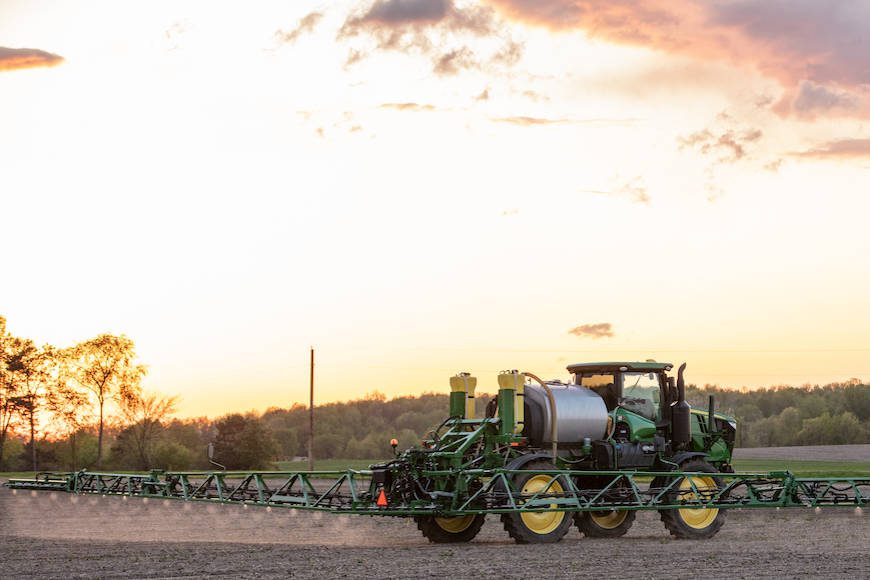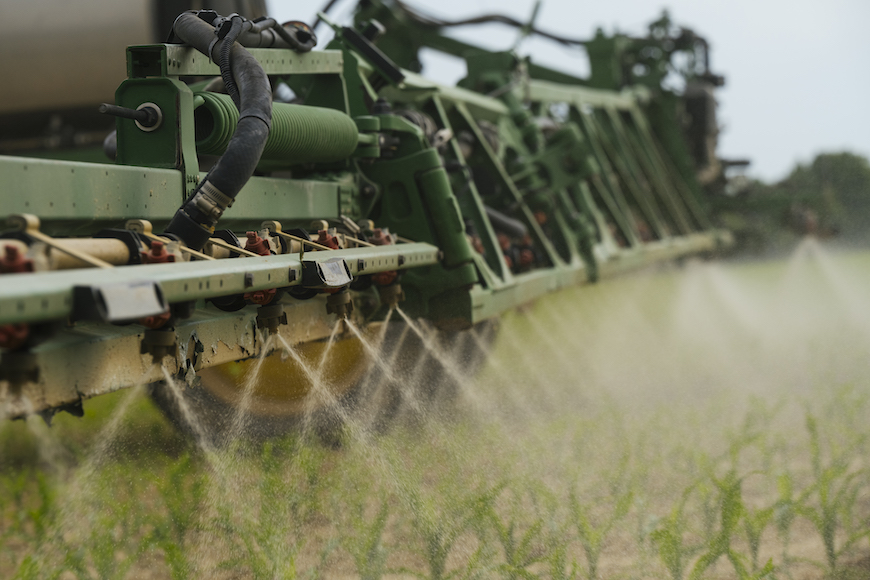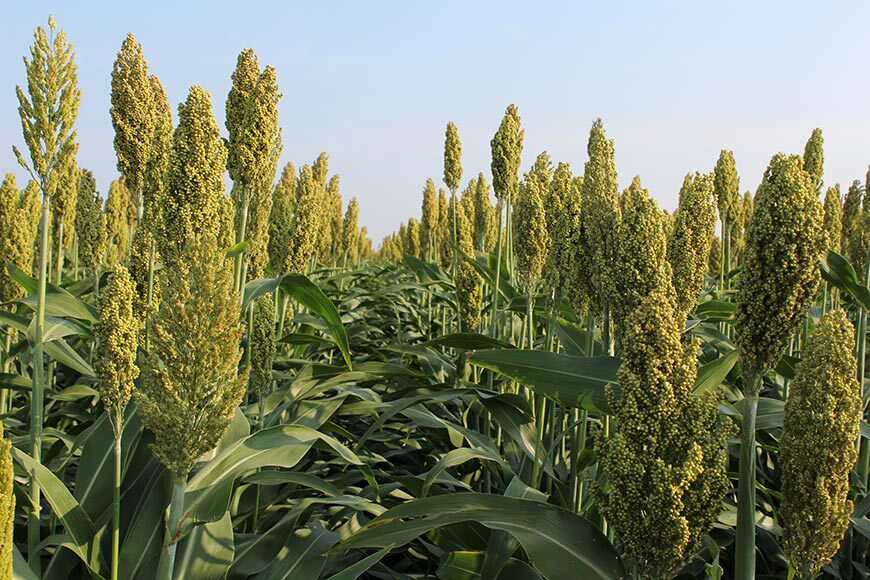Why Fall Burndown Beats Spring Weed Control

As farmers in the Northern Plains know all too well, relying on fall tillage to break up weed pressure approaching winter comes with some risk, especially if you end up not working the fields. When dry field conditions force producers to leave fields with bare stubble to conserve moisture, they can face heightened weed pressure in the spring.
That’s why I always encourage making a burndown application in the fall when weeds are easiest to control. This is incredibly important for those who practice minimum- or no-till and have a history of winter annuals.
So why do some farmers shy away from making a fall burndown application? If I had to guess, I’d say most don’t want the added cost. This application comes when you have finally recouped input costs from the spring crop and are looking to purchase seed for next year. I understand this hesitation, but a fall burndown is often more cost-efficient and produces cleaner results in the long run.
Provided you’re planting a herbicide-resistant crop next spring, all you need to include in your burndown application this fall is glyphosate, a growth regulator like 2,4-D to target glyphosate-resistant weeds and the appropriate adjuvant package. I usually recommend a tank mix containing the following products:
For an average cost of about $12-15 per acre1, this application can wipe out most weed concerns leading up to winter and help prevent them from returning early next spring. Just be sure to consult your local WinField® United retailer for assistance in determining the best product rates for your fields.
Or, if you’re planting a conventional crop, wheat on no-till or minimum-till acres or pulse crops like peas, lentils, chickpeas or dry edible beans, it’s best to include a fall residual product in your burndown tank mix. An effective flumioxazin option like Valor® herbicide applied in the fall will continue to suppress marestail, narrowleaf hawksbeard and downy brome in the spring.
Whichever of these products you choose, relying on it for your spring herbicide application will cost about $25 per acre.1 You’d hope to get excellent control for that investment, but these tank mixes are not a silver bullet. Since weeds that started growing in fall are larger and harder to manage come spring, farmers often are disappointed by the modest results they attain.
Choosing between spending $12-15 per acre this fall when weeds are smaller and easier to control or waiting until weeds are larger and potentially more costly to eradicate is a no-brainer. Depending on the size of your operation, you can save on input costs with a fall burndown application, all while receiving better results.
Here is an example of what a late application can do: one year, a burndown application was made on some volunteer wheat in a local grower’s field. As it turned out, it snowed the next day and didn’t end up melting off until spring. You may think the application would be a lost cause, but on the contrary — there were excellent results in the spring. In addition to eliminating the volunteer wheat, there were perfect strips of black soil where the ground was sprayed, but carpets of cheatgrass had started growing in the unsprayed border areas.
If you’re tired of large weeds and winter grasses outlasting your spring herbicide treatment and reducing your yield potential, consider making a burndown application this fall. Your local WinField United retailer will help custom tailor the right tank mix for your operation.
1 Per acre herbicide application costs are supplied only as an estimate and will vary depending on current pricing and rates.
All photos are either the property of WinField United or used with permission.
© 2025 WinField United. Important: Before use always read and follow label instructions. Crop performance is dependent on several factors many of which are beyond the control of WinField United, including without limitation, soil type, pest pressures, agronomic practices and weather conditions. Growers are encouraged to consider data from multiple locations, over multiple years and to be mindful of how such agronomic conditions could impact results. Class Act, Cornerstone, InterLock, NG, Shredder and WinField are trademarks of WinField United. All other trademarks are the property of their respective owners.
That’s why I always encourage making a burndown application in the fall when weeds are easiest to control. This is incredibly important for those who practice minimum- or no-till and have a history of winter annuals.
So why do some farmers shy away from making a fall burndown application? If I had to guess, I’d say most don’t want the added cost. This application comes when you have finally recouped input costs from the spring crop and are looking to purchase seed for next year. I understand this hesitation, but a fall burndown is often more cost-efficient and produces cleaner results in the long run.
Fall Burndown Provides Efficacy at a Low Cost
The good news is that a fall burndown application doesn’t need to be complicated or expensive to be effective. In fact, even a late fall burndown made shortly before freezing is likely to provide far better results than a spring herbicide tank mix at a fraction of the cost.Provided you’re planting a herbicide-resistant crop next spring, all you need to include in your burndown application this fall is glyphosate, a growth regulator like 2,4-D to target glyphosate-resistant weeds and the appropriate adjuvant package. I usually recommend a tank mix containing the following products:
- Cornerstone® 5 Plus herbicide (glyphosate).
- Shredder® E-99 herbicide (2,4-D).
- Class Act® NG® adjuvant, which contains a quality nonionic surfactant.
- InterLock® adjuvant to lock in spray coverage and lock out drift.
For an average cost of about $12-15 per acre1, this application can wipe out most weed concerns leading up to winter and help prevent them from returning early next spring. Just be sure to consult your local WinField® United retailer for assistance in determining the best product rates for your fields.
Is Residual Chemistry Needed?
If you’re planting a herbicide-tolerant crop next season, it isn’t necessary to include a residual herbicide in your fall burndown application unless you’re dealing with a complex weed issue. In most cases, you can simply come back next spring and clean up newly sprouted weeds with the appropriate post-emergent herbicide application.Or, if you’re planting a conventional crop, wheat on no-till or minimum-till acres or pulse crops like peas, lentils, chickpeas or dry edible beans, it’s best to include a fall residual product in your burndown tank mix. An effective flumioxazin option like Valor® herbicide applied in the fall will continue to suppress marestail, narrowleaf hawksbeard and downy brome in the spring.
The Downsides of Relying on a Spring Application
Wheat producers who practice minimum- or no-till and skip burndown applications this fall will be forced to deal with broadleaf weeds and downy brome next spring. Pyroxsulam products like OpenSky® and GoldSky® herbicides are the best options for controlling downy brome on wheat and other cereal crops. Everest® 3.0 herbicide also offers residual control, but it isn’t used as often as the others due to its longer rotational restrictions.Whichever of these products you choose, relying on it for your spring herbicide application will cost about $25 per acre.1 You’d hope to get excellent control for that investment, but these tank mixes are not a silver bullet. Since weeds that started growing in fall are larger and harder to manage come spring, farmers often are disappointed by the modest results they attain.
Choosing between spending $12-15 per acre this fall when weeds are smaller and easier to control or waiting until weeds are larger and potentially more costly to eradicate is a no-brainer. Depending on the size of your operation, you can save on input costs with a fall burndown application, all while receiving better results.
Timing is Important, But Not an End All
The best time to make your fall burndown application is when weeds germinate after harvest, generally mid-September in the Northern Plains. However, you can still achieve adequate control if you apply a fall burndown before the first heavy freeze or even post-freeze if warmer temperatures return for an extended amount of time before winter ultimately arrives.Here is an example of what a late application can do: one year, a burndown application was made on some volunteer wheat in a local grower’s field. As it turned out, it snowed the next day and didn’t end up melting off until spring. You may think the application would be a lost cause, but on the contrary — there were excellent results in the spring. In addition to eliminating the volunteer wheat, there were perfect strips of black soil where the ground was sprayed, but carpets of cheatgrass had started growing in the unsprayed border areas.
If you’re tired of large weeds and winter grasses outlasting your spring herbicide treatment and reducing your yield potential, consider making a burndown application this fall. Your local WinField United retailer will help custom tailor the right tank mix for your operation.
1 Per acre herbicide application costs are supplied only as an estimate and will vary depending on current pricing and rates.
All photos are either the property of WinField United or used with permission.
© 2025 WinField United. Important: Before use always read and follow label instructions. Crop performance is dependent on several factors many of which are beyond the control of WinField United, including without limitation, soil type, pest pressures, agronomic practices and weather conditions. Growers are encouraged to consider data from multiple locations, over multiple years and to be mindful of how such agronomic conditions could impact results. Class Act, Cornerstone, InterLock, NG, Shredder and WinField are trademarks of WinField United. All other trademarks are the property of their respective owners.




